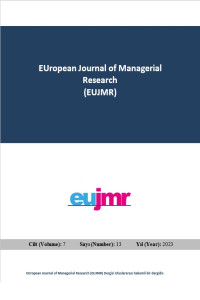Öz
Bir toplumda fiziksel çevrenin bakımsız olması ya da çevrede oluşan küçük hasarlara müdahale edilmemesi o bölgedeki yetkililerin çevresel olaylara karşı duyarsız olduğu izlenimini yaratabilmektedir. Böyle bir çevrede ufak-tefek suçlar işlenebilmekte, söz konusu suçları işleyenler herhangi bir caydırıcı yaptırımla karşılaşmadığında bu ortamda daha büyük suçların işlenmesinin önü açılabilmektedir. Bu durum Kırık Camlar Teorisi ile açıklanabilmektedir. Kırık Camlar Teorisinde toplumda önemsiz gibi görünen olaylara müdahale edilmediğinde daha büyük ve toplumda ciddi etkileri olabilecek olayların meydana gelebileceği ileri sürülmektedir. Teori, bir yerleşim yerinde çalışanlarıyla bir topluluğu oluşturduğundan işletmeler için söz konusu olabilmektedir. İşletmelerde fiziksel çalışma koşullarının çalışanların işyeri refahına göre düzenlenmemesi çalışanlar arasında yöneticilerin ihmalkârlığı olarak algılanabilmektedir. Bu durum çalışanların görevlerini aksatmalarına, görevini aksatan çalışanlara müdahale edilmediğinde ise üretim karşıtı davranışların çalışanlar arasında yayılmasına neden olabilmektedir. Bu çalışmada Kırık Camlar Teorisine ilişkin öncelikle kavramsal bir çerçeve çizilmiş, daha sonra işletmeler açısında ele alınan teori hakkında ayrıntılı bilgi verilmiştir. Çalışmanın amacı teori kapsamında işletme yöneticilerinin önemsiz görebildikleri durumlara müdahale etmemelerinin uzun vadedeki sonuçlarını ortaya koymak ve bu sonuçların ortaya çıkmasını engellemek için yöneticilere yapılabilecek önlemlere dair öneriler sunmaktır.
Anahtar Kelimeler
Kaynakça
- Abdullah, A., Marzbali, M. H., Bahauddin, A., & Tilaki, M. J. (2015). Broken windows and collective efficacy: Do they affect fear of crime? Sage Open, 5(1), 1-11.
- Austrup, S. (2011). The person behind the “broken window”: The influence of the environment and personality on undesired behavior. (Bachelor's thesis), University of Twente, Hollanda
- Bektaş, M., Erkal, P., & Çetin, D. T. (2019). Kırık Camlar Teorisinin işletmelere uyarlanması: Ölçek geliştirme çalışması. Ankara Hacı Bayram Veli Üniversitesi İktisadi ve İdari Bilimler Fakültesi Dergisi, 21(3), 596-617.
- Biçer, C. (2022). Broken windows effect in organizations: A focus on counterproductive work behaviors that lead to employee burnout and employee turnover and solutions. Tarsus Üniversitesi İktisadi ve İdari Bilimler Fakültesi Dergisi, 3(1), 28-45.
- Bratton, W. J. (1998). Crime is down in New York city: Blame the police. N. Dennis (Ed.), Zero Tolerance: Policing A Free Society (s. 29-43). Great Britain: IEA Health and Welfare Unit
- Bratton, W. J., & Kelling, G. L. (2015). Why we need broken windows policing. City Journal, 25(1), 10-17.
- Güven, M., & Akmeşe, A. (2021). Kırık camlar teorisi bağlamında yönetim tarzlarının değerlendirilmesi: Bir alan araştırması. A. M. Sahabi içinde, İşletmelerde Güncel Sorunlar ve Çözüm Önerileri (s. 75-86). İstanbul: Eğitim Yayınevi.
- Keizer, K., Lindenberg, S., & Steg, L. (2008). The spreading of disorder. Science, 322(5908), 1681-1685.
- Kelling, G. L., & Wilson, J. Q. (1982). Broken windows. Atlantic Monthly, 249(3), 29-38.
- Maskaly, J., & Boggess, L. N. (2014). Broken windows theory. The Encyclopedia of Theoretical Criminology, 1-4.
- Mohan, D. R., Kumar, S. S., & Subrahmanyam, G. (2013). Management by walking around: An effective tool for day-to-day operations of Hospital. IUP Journal of Operations Management, 12(1), 58.
- Muniz, A. (2011). Disorderly community partners and broken windows policing. Ethnography, 13(3), 330-351.
- Nalçacıgil, E. (2020). Contributions to the organizational administration of the broken windows theory. International Social Sciences Studies Journal, 6(62), 2149-2157.
- O'brien, D. T., Farrell, C., & Welsh, B. C. (2019). Broken (windows) theory: A meta-analysis of the evidence for the pathways from neighborhood disorder to resident health outcomes and behaviors. Social Science & Medicine, 228, 272-292.
- Pollard, C. (1998). Zero tolerance: Short-term fix, long-term liability? N. Dennis, (Ed.), Zero tolerance: Policing a free society (s. 44-61). Great Britain: IEA health and welfare unit.
- Prieto, L. C., Norman, M. V., Phipps, S. T., & Chenault, E. B. (2016). Tackling micro-aggressions in organizations: A broken windows approach. Journal of Leadership, Accountability & Ethics, 13(3), 36-49.
- Ramos, J., & Torgler, B. (2012). Are academics messy? Testing the broken windows theory with a field experiment in the work environment. Review of Law & Economics, 8(3), 563-577.
- Robinson, S. L., & Bennett, R. J. (1995). A typology of deviant workplace behaviors: A multidimensional scaling study. Academy of Management Journal, 38(2), 555-572.
- Salin, D. (2014). Risk factors of workplace bullying for men and women: The role of the psychosocial and physical work environment. Scandinavian Journal of Psychology, 56(1), 69-77.
- Şenol, L. (2022). Örgütsel kırık camların üretim karşıtı iş davranışları üzerine etkisi: Hizmet sektöründe bir araştırma. International Social Sciences Studies Journal, 8(97), 1518-1526.
- Torgler, B., Frey, B. S., & Wilson, C. (2009). Environmental and pro-social norms: Evidence on littering. The BE Journal of Economic Analysis & Policy, 9(1), 1-39.
- Üzüm, B., Özkan, O. S., & Çakan, S. (2022). Moral disengagement, organizational broken window, person-organization fit as an antecedent: Machiavellian leadership. Journal of Organizational Behavior Research, 7(1), 29-41.
- Vischer, J. C., & Wifi, M. (2017). The effect of workplace design on quality of life at work. G. Fleury-Bahi, E. Pol, & O. Navarro içinde, Handbook of Environmental Psychology and Quality of Life Research (s. 387-400). Switzerland: Springer.
- Weil, D. (2012). “Broken windows,” vulnerable workers, and the future of worker representation. The Forum, 10(1), 1-21.
- Weisburd, D., Hinkle, J. C., Braga, A. A., & Wooditch, A. (2015). Understanding the mechanisms underlying broken windows policing: The need for evaluation evidence. Journal of Research in Crime and Delinquency, 52(4), 589-608.
- Williams, M. (2019, Ağustos 08). Broken windows theory in workplace management & business strategy. Rancord Society: https://www.rancord.org/broken-windows-theory-business-management-strategy
- Yazıcı, N. (2018). Hile üçgeni: Fırsatların önlenmesinde kırık camlar teorisi. Üçüncü Sektör Sosyal Ekonomi, 53(3), 843-851.
- Zimbardo, P. G. (1969). The human choice: Individuation, reason, and order versus deindividuation, impulse, and chaos. Nebraska symposium on motivation (s. 237-307). Nebraska: University of Nebraska press.
- Zimbardo, P. G. (1970). A Social-Psychological analysis of vandalism: Making sense of senseless violence. Springfield: National Technical Information Service.
Öz
In a society, the neglect of the settings or the failure to address minor damages in the surroundings can create an impression that the authorities are insensitive to environmental issues. Such an environment, minor offenses can be committed, and when the perpetrators of these offenses don’t face any deterrent sanctions, it can pave the way for more significant crimes to be committed in that setting. This situation can be explained by the Broken Windows Theory. The Broken Windows Theory suggests that when seemingly insignificant incidents are not intervened within a community, it may lead to occurrence of larger events with serious societal consequences. The theory can be applicable to businesses as it forms a community with its employees within a settlement. In businesses, the failure to arrange the physical working conditions according to the well-being of the employees can be perceived as negligence on the part of the managers. This situation can lead to employees neglecting their duties, and when no intervention occurs with employees failing in their tasks, it can result in the spread of counterproductive behaviors among the employees. In this study, a conceptual framework is initially outlined regarding the Broken Windows Theory, followed by detailed information about the theory as applied to businesses. The aim of the study is to reveal the long-term consequences of managers not intervening in seemingly insignificant situations within the scope of the theory, and to provide recommendations for measures that can be taken by managers to prevent emergence of these consequences.
Anahtar Kelimeler
Kaynakça
- Abdullah, A., Marzbali, M. H., Bahauddin, A., & Tilaki, M. J. (2015). Broken windows and collective efficacy: Do they affect fear of crime? Sage Open, 5(1), 1-11.
- Austrup, S. (2011). The person behind the “broken window”: The influence of the environment and personality on undesired behavior. (Bachelor's thesis), University of Twente, Hollanda
- Bektaş, M., Erkal, P., & Çetin, D. T. (2019). Kırık Camlar Teorisinin işletmelere uyarlanması: Ölçek geliştirme çalışması. Ankara Hacı Bayram Veli Üniversitesi İktisadi ve İdari Bilimler Fakültesi Dergisi, 21(3), 596-617.
- Biçer, C. (2022). Broken windows effect in organizations: A focus on counterproductive work behaviors that lead to employee burnout and employee turnover and solutions. Tarsus Üniversitesi İktisadi ve İdari Bilimler Fakültesi Dergisi, 3(1), 28-45.
- Bratton, W. J. (1998). Crime is down in New York city: Blame the police. N. Dennis (Ed.), Zero Tolerance: Policing A Free Society (s. 29-43). Great Britain: IEA Health and Welfare Unit
- Bratton, W. J., & Kelling, G. L. (2015). Why we need broken windows policing. City Journal, 25(1), 10-17.
- Güven, M., & Akmeşe, A. (2021). Kırık camlar teorisi bağlamında yönetim tarzlarının değerlendirilmesi: Bir alan araştırması. A. M. Sahabi içinde, İşletmelerde Güncel Sorunlar ve Çözüm Önerileri (s. 75-86). İstanbul: Eğitim Yayınevi.
- Keizer, K., Lindenberg, S., & Steg, L. (2008). The spreading of disorder. Science, 322(5908), 1681-1685.
- Kelling, G. L., & Wilson, J. Q. (1982). Broken windows. Atlantic Monthly, 249(3), 29-38.
- Maskaly, J., & Boggess, L. N. (2014). Broken windows theory. The Encyclopedia of Theoretical Criminology, 1-4.
- Mohan, D. R., Kumar, S. S., & Subrahmanyam, G. (2013). Management by walking around: An effective tool for day-to-day operations of Hospital. IUP Journal of Operations Management, 12(1), 58.
- Muniz, A. (2011). Disorderly community partners and broken windows policing. Ethnography, 13(3), 330-351.
- Nalçacıgil, E. (2020). Contributions to the organizational administration of the broken windows theory. International Social Sciences Studies Journal, 6(62), 2149-2157.
- O'brien, D. T., Farrell, C., & Welsh, B. C. (2019). Broken (windows) theory: A meta-analysis of the evidence for the pathways from neighborhood disorder to resident health outcomes and behaviors. Social Science & Medicine, 228, 272-292.
- Pollard, C. (1998). Zero tolerance: Short-term fix, long-term liability? N. Dennis, (Ed.), Zero tolerance: Policing a free society (s. 44-61). Great Britain: IEA health and welfare unit.
- Prieto, L. C., Norman, M. V., Phipps, S. T., & Chenault, E. B. (2016). Tackling micro-aggressions in organizations: A broken windows approach. Journal of Leadership, Accountability & Ethics, 13(3), 36-49.
- Ramos, J., & Torgler, B. (2012). Are academics messy? Testing the broken windows theory with a field experiment in the work environment. Review of Law & Economics, 8(3), 563-577.
- Robinson, S. L., & Bennett, R. J. (1995). A typology of deviant workplace behaviors: A multidimensional scaling study. Academy of Management Journal, 38(2), 555-572.
- Salin, D. (2014). Risk factors of workplace bullying for men and women: The role of the psychosocial and physical work environment. Scandinavian Journal of Psychology, 56(1), 69-77.
- Şenol, L. (2022). Örgütsel kırık camların üretim karşıtı iş davranışları üzerine etkisi: Hizmet sektöründe bir araştırma. International Social Sciences Studies Journal, 8(97), 1518-1526.
- Torgler, B., Frey, B. S., & Wilson, C. (2009). Environmental and pro-social norms: Evidence on littering. The BE Journal of Economic Analysis & Policy, 9(1), 1-39.
- Üzüm, B., Özkan, O. S., & Çakan, S. (2022). Moral disengagement, organizational broken window, person-organization fit as an antecedent: Machiavellian leadership. Journal of Organizational Behavior Research, 7(1), 29-41.
- Vischer, J. C., & Wifi, M. (2017). The effect of workplace design on quality of life at work. G. Fleury-Bahi, E. Pol, & O. Navarro içinde, Handbook of Environmental Psychology and Quality of Life Research (s. 387-400). Switzerland: Springer.
- Weil, D. (2012). “Broken windows,” vulnerable workers, and the future of worker representation. The Forum, 10(1), 1-21.
- Weisburd, D., Hinkle, J. C., Braga, A. A., & Wooditch, A. (2015). Understanding the mechanisms underlying broken windows policing: The need for evaluation evidence. Journal of Research in Crime and Delinquency, 52(4), 589-608.
- Williams, M. (2019, Ağustos 08). Broken windows theory in workplace management & business strategy. Rancord Society: https://www.rancord.org/broken-windows-theory-business-management-strategy
- Yazıcı, N. (2018). Hile üçgeni: Fırsatların önlenmesinde kırık camlar teorisi. Üçüncü Sektör Sosyal Ekonomi, 53(3), 843-851.
- Zimbardo, P. G. (1969). The human choice: Individuation, reason, and order versus deindividuation, impulse, and chaos. Nebraska symposium on motivation (s. 237-307). Nebraska: University of Nebraska press.
- Zimbardo, P. G. (1970). A Social-Psychological analysis of vandalism: Making sense of senseless violence. Springfield: National Technical Information Service.
Ayrıntılar
| Birincil Dil | Türkçe |
|---|---|
| Konular | İnsan Kaynakları Yönetimi |
| Bölüm | Kavramsal Makale |
| Yazarlar | |
| Erken Görünüm Tarihi | 30 Aralık 2023 |
| Yayımlanma Tarihi | 31 Aralık 2023 |
| Yayımlandığı Sayı | Yıl 2023 Cilt: 7 Sayı: 13 |




